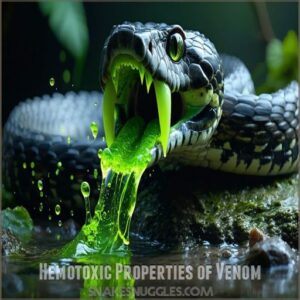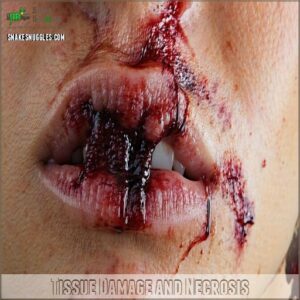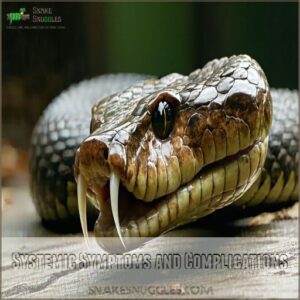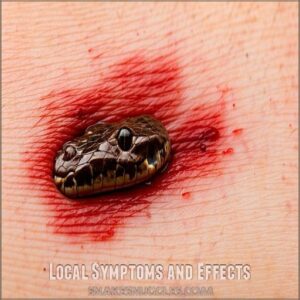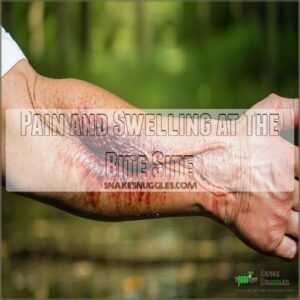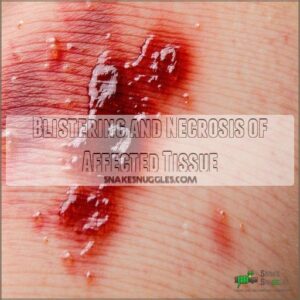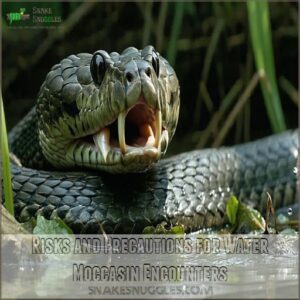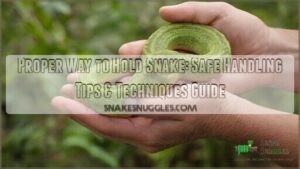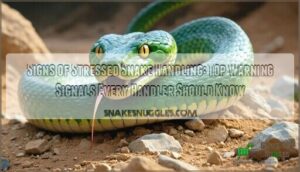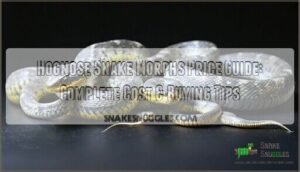This site is supported by our readers. We may earn a commission, at no cost to you, if you purchase through links.
 While a water moccasin can potentially kill you, fatalities are extremely rare with prompt medical care.
While a water moccasin can potentially kill you, fatalities are extremely rare with prompt medical care.
These venomous snakes pack a hemotoxic punch that disrupts blood clotting and damages tissue, causing intense pain, swelling, and potentially life-threatening complications.
If you’re bitten, don’t panic—your survival odds are high if you act quickly. Immediate medical attention is vital, as antivenom can neutralize the snake’s toxic cocktail.
The key is staying calm, immobilizing the affected limb, and getting professional help fast. Remember, these serpents are more scared of you than you are of them, and most bites occur when the snake feels threatened.
Table Of Contents
- Key Takeaways
- Water Moccasin Venom Effects
- Can a Water Moccasin Kill You
- Water Moccasin Bite Symptoms
- Risks and Precautions for Water Moccasin Encounters
- Treating a Water Moccasin Bite
- Frequently Asked Questions (FAQs)
- Are water moccasins dangerous?
- Is ricin lethal?
- How to remove a water moccasin?
- Can a water moccasin bite cause death?
- Do water moccasins have venom?
- Can water moccasins bite you underwater?
- Can you survive a water moccasin bite?
- How lethal are water moccasins?
- Will a water moccasin kill a dog?
- Can you kill a water moccasin in Florida?
- Conclusion
Key Takeaways
- You won’t die from a water moccasin bite if you get prompt medical attention; fatalities are extremely rare when antivenom is administered quickly.
- The snake’s hemotoxic venom can cause serious complications, such as tissue damage, blood clotting disruption, and systemic symptoms, making immediate medical intervention critical.
- Your survival depends on staying calm, immobilizing the bitten limb, and calling emergency services within the first few hours after being struck.
- While water moccasins are venomous and potentially deadly, they are more scared of you and typically won’t attack unless they feel threatened or cornered.
Water Moccasin Venom Effects
If you’re bitten by a water moccasin, you’ll want to understand how its venom can wreak havoc on your body.
The snake’s hemotoxic venom attacks your blood cells and tissues, potentially causing serious complications.
This can turn a wilderness encounter into a medical emergency.
Hemotoxic Properties of Venom
In five destructive steps, water moccasin venom wreaks cellular carnage. Its hemotoxic components are nature’s precision weapon, targeting your body’s intricate systems with remarkable efficiency.
Fortunately, cottonmouths aren’t typically aggressive, with research on cottonmouth aggression showing minimal bites even when provoked.
- Red blood cell destruction triggers systemic chaos
- Targeted tissue damage begins immediately
- Protein interactions dismantle cellular structures
- Venom spreads through bloodstream rapidly
- Cellular integrity collapses under toxic assault
Disruption of Blood Clotting
Cottonmouth venom frequently wreaks havoc on your body’s blood clotting mechanisms.
Its powerful hemotoxins disrupt venoms clotting factors, transforming your blood into a chaotic flow. Metalloproteinases trigger coagulopathy, preventing normal platelet aggregation and compromising fibrinolysis.
This biochemical assault turns your bloodstream into a potential disaster zone, where normal clotting becomes impossible, leaving you vulnerable to uncontrolled bleeding.
Understanding the effects of cottonmouth venom can be key in finding the right treatment products, such as those found in cottonmouth venom treatments.
Tissue Damage and Necrosis
Water moccasin venom packs a punch that can turn your skin into a horror show. Those nasty enzymes trigger cellular damage faster than you can say "ouch," causing tissue to blacken and rot.
Your body becomes a battlefield where venom breaks down healthy cells, leaving behind blistered, dying tissue.
Quick medical help is your best defense against this snake bite. Prompt medical attention is vital to minimize long-term complications, including antivenom therapy.
Systemic Symptoms and Complications
Triggering a cascade of systemic chaos, water moccasin venom can wreak havoc beyond the bite site.
Your body might experience a roller coaster of dangerous symptoms:
- Plummeting blood pressure threatening to knock you off your feet
- Nausea and vomiting turning your stomach inside out
- Respiratory distress making each breath a battle
Swift medical intervention is your lifeline against these potentially fatal complications.
Can a Water Moccasin Kill You
If you encounter a water moccasin, your survival depends on quick, informed action.
Understanding the snake’s venom is crucial.
Seeking immediate medical attention can mean the difference between a manageable bite and a life-threatening situation.
Rarity of Fatalities From Water Moccasin Bites
After exploring the venom’s toxic punch, let’s clear the air about water moccasin fatalities.
Your chances of dying from a bite are slim – most victims walk away with a wild story.
According to antivenom therapy, prompt medical care dramatically improves survival odds.
So while these serpents pack a venomous wallop, they’re not the grim reaper you might imagine.
Factors Influencing Bite Severity and Outcomes
Ever wondered what turns a water moccasin bite from bad to deadly? Size matters—a larger snake injects more venom.
Your age, bite location, and health play critical roles. A young child or older adult might face graver risks.
Your body’s response is a wild card, and waiting too long can transform a serious bite into a life-threatening emergency.
Given that around 8,000 US snakebites occur annually according to the CDC, taking all snakebites seriously is imperative.
Importance of Immediate Medical Attention
When a water moccasin strikes, your next moves can mean life or death. Quick medical response isn’t just smart—it’s survival. Having a water moccasin first aid kit nearby can also be extremely helpful.
- Stay calm and still
- Keep the bite below heart level
- Remove constrictive clothing
- Call emergency services now
- Document bite details
Time is your most critical weapon against venom’s devastating potential. Don’t gamble with delays.
Role of Antivenom in Treatment and Survival
After rushing to the hospital, your lifeline against a water moccasin’s deadly bite is antivenom. This medical marvel can turn the tide of a potentially fatal encounter.
Here’s what you need to know:
- Antivenom effectiveness varies by snake species
- Quick administration dramatically improves survival rates
- Potential side effects include allergic reactions
- Research continues to enhance antivenom treatments
- Not all hospitals carry specific snake bite antivenom
Don’t gamble with your life—seek immediate medical attention and trust the science that could save you.
Water Moccasin Bite Symptoms
If you’re unfortunate enough to be bitten by a water moccasin, you’ll immediately notice intense pain, swelling, and potential tissue damage at the bite site.
Understanding the specific symptoms can help you recognize the severity of the envenomation.
Prompt medical attention can potentially prevent serious complications.
Local Symptoms and Effects
A water moccasin’s bite immediately triggers a cascade of tissue destruction.
Sharp pain erupts as venom infiltrates your skin, sparking localized inflammation.
Redness spreads rapidly, accompanied by bleeding and potential blistering. Tissue begins breaking down at the bite site, creating a vivid map of the snake’s toxic assault on your body. venom infiltrates your skin.
Pain and Swelling at The Bite Site
Building on local symptoms, the water moccasin bite brings a painful punch that’ll make you wince. The bite pain intensity skyrockets within minutes, triggering an inflammatory response that’s anything but subtle.
Watch out for these telltale signs: In fact, water moccasins are known to be highly venomous water snakes.
- Searing pain radiating from the wound
- Rapid swelling that spreads like wildfire
- Throbbing sensations that demand immediate attention
Edema treatment becomes your top priority.
Blistering and Necrosis of Affected Tissue
When a water moccasin strikes, its venom triggers a brutal tissue damage cascade.
You’ll spot blistering and necrotic patches spreading like wildfire across skin. Blister formation signals the snake’s potent toxins working overtime, transforming healthy tissue into a warning sign of potential long-term consequences.
Quick medical intervention stops the venom’s destructive path, preventing permanent scarring.
Hemotoxic venom from a water moccasin bite also poses a significant risk of infection, as noted in documented cottonmouth snake encounters.
Risks and Precautions for Water Moccasin Encounters
When you’re exploring areas known for water moccasins, understanding their habitat and behavior is key for your safety.
By learning to recognize warning signs, maintaining a safe distance, and taking preventive measures, you can greatly reduce your risk of a dangerous encounter with these potentially venomous snakes.
Habitat and Territory of Water Moccasins
In the southeastern US, water moccasins (cottonmouths) call wetlands their home turf. Their preferred habitats span a diverse landscape, with the Nearctic native range being particularly suitable for their semiaquatic lifestyle Southeastern US habitats.
- Freshwater lakes and slow-moving rivers
- Coastal marshes and swamps
- Agricultural drainage ditches
- Urban water features
- Wooded stream banks
With territories averaging 1.06 hectares, these venomous snakes stick close to water sources, making unexpected encounters a real possibility.
Warning Signs and Threat Displays
Three telltale signs reveal a water moccasin’s defensive stance. Their body coils into an S-shape, head flattened like a lethal pancake, ready to strike. Watch for tail vibrations and an open, cotton-white mouth—nature’s warning lights.
When encountering a water moccasin, it’s key to remain calm and slowly back away, as recommended by the Texas water snake safety measures.
| Signal | Meaning |
|---|---|
| S-shaped Coil | Defensive Posture |
| Flattened Head | Preparing to Strike |
| Tail Vibration | Imminent Threat Warning |
| Open Mouth | Fang Display |
| Hissing Sounds | Aggression Indicator |
Safe Distances and Precautions for Humans
A water moccasin’s territorial nature demands your respect and strategic awareness. Using effective water moccasin repellent can be a key aspect of snake control.
Stay alert in their domain with these essential precautions:
- Maintain a minimum six-foot safety radius
- Avoid marshy, swampy habitats where snakes lurk
- Wear protective footwear and use clear pathways
Emergency preparedness can turn a potential snake encounter from risky to manageable.
Preventing Water Moccasin Bites and Encounters
Treading carefully in water moccasin territory demands smart strategy.
Wear snake-proof boots, stay alert in murky waters, and learn their distinctive dark-banded appearance.
Keep first aid nearby and maintain safe distances.
By understanding their habitat and behavior, you’ll minimize the risk of unexpected encounters and potential water moccasin bites.
Treating a Water Moccasin Bite
If you’ve been bitten by a water moccasin, your immediate actions can make the difference between life and potential serious complications.
Stay calm, immobilize the affected limb, and seek emergency medical attention right away.
minimize the risk of venom-related damage and guarantee proper treatment.
First Aid and Immediate Response
When a water moccasin strikes, your calm response is your lifeline.
Gently clean the wound with soap and water, avoiding scrubbing. Immobilize the bitten limb at heart level.
Don’t try heroics—no tourniquet or snake capture needed. Call 911 immediately.
Skip folklore remedies. Stay still, stay focused, and let professionals handle this venomous encounter.
Antivenom Administration and Dosage
After first aid, antivenom becomes your lifeline against water moccasin venom. Here’s what you need to know:
- Dosage: Typically 4-6 vials of Crotalidae polyvalent immune Fab
- Administration: Intravenous, under medical supervision
- Efficacy: Critical for neutralizing venom’s deadly effects
- Timing: Most effective within 6 hours of bite
- Monitoring: Watch for potential hypersensitivity reactions
Your medical team will determine the precise treatment protocol.
Pain Management and Wound Care
Treating a water moccasin bite demands swift, strategic wound care.
You’ll need acetaminophen for pain, saline for cleaning, and elevation to reduce swelling.
Keep the wound moist, apply aloe vera to minimize scarring, and watch for infection signs.
Texas snake bites (https://today.tamu.edu/2020/06/18/snakes-are-out-in-texas-heres-how-to-reduce-encounters-with-them/) often occur on feet or lower legs, emphasizing the importance of being aware of your surroundings.
Your quick, calm response can prevent serious complications from water moccasin venom.
Monitoring for Systemic Complications and Long-Term Effects
Once the dust settles from your antivenom treatment, your recovery journey begins. Snakebite complications can lurk like shadows, potentially emerging weeks after the initial bite. Keep in mind that the severity of a bite and the speed of symptom onset depend on factors such as venom type and amount.
- Monitor kidney function closely
- Watch for unexpected neurological symptoms
- Document any developing skin changes
- Track potential scarring progression
- Report unusual reactions to healthcare providers
Your body’s healing path isn’t a sprint—it’s a marathon of careful observation and patient recovery. This is a long process requiring close monitoring of potential complications.
Frequently Asked Questions (FAQs)
Are water moccasins dangerous?
Water moccasins can be deadly if untreated, but they’d rather avoid you.
Stay alert near water, wear shoes, and don’t provoke them.
If bitten, seek immediate medical help to prevent serious complications.
Is ricin lethal?
Just 7mg of ricin could kill you fast.
You’d face severe symptoms within hours, potentially triggering multiple organ failure if untreated.
One milligram can be fatal, making it an incredibly potent toxin.
How to remove a water moccasin?
Steer clear of direct confrontation.
Call a professional wildlife removal service specializing in snake relocation.
Seal potential entry points, remove debris, and keep your yard clean to discourage cottonmouths from settling near your home.
Can a water moccasin bite cause death?
When death’s shadow looms, a water moccasin’s bite can be fatal if untreated.
You’ll need immediate medical attention.
antivenom, and professional care to prevent potentially life-threatening complications from this venomous snake’s toxic strike.
Do water moccasins have venom?
You’ll definitely want to know: water moccasins carry potent venom that can cause serious tissue damage and coagulopathy.
Their fangs deliver a toxic cocktail that disrupts blood and cell membranes, demanding immediate medical attention if bitten.
Can water moccasins bite you underwater?
Water moccasins can’t bite underwater effectively.
Their venom requires contact with tissue, and they’re not adapted to strike while fully submerged.
They’ll surface or retreat if threatened in water, preferring defensive strategies over underwater attacks.
Can you survive a water moccasin bite?
Most cottonmouth bites aren’t fatal if you seek prompt medical attention.
Antivenom effectively treats envenomation.
Stay calm, immobilize the affected limb, and get to a hospital quickly to minimize potential complications from the snake’s venomous bite.
How lethal are water moccasins?
While rarely fatal, cottonmouth bites can turn deadly if you’re unlucky.
Don’t panic, but seek immediate medical help—antivenom and prompt treatment dramatically reduce risks, ensuring you’ll likely survive this venomous encounter.
Will a water moccasin kill a dog?
A water moccasin’s venomous bite can kill a dog if untreated. Your pet needs immediate veterinary care after a snake encounter to prevent potentially fatal complications from the toxic bite.
Can you kill a water moccasin in Florida?
In Florida, you can legally kill a water moccasin (cottonmouth) on your property if it poses an immediate threat.
Experts recommend keeping a safe distance and calling professional wildlife removal services instead.
Conclusion
Ultimately, knowledge is your best defense against water moccasin bites.
You’ve learned that while these venomous snakes can kill you, fatalities are incredibly rare with swift medical intervention.
Stay alert, respect their space, and understand their behavior.
If bitten, remain calm, seek immediate professional help, and trust modern medical treatments. Your survival chances are high when you act quickly and rationally.
Remember, prevention and quick response are your strongest allies in dealing with these formidable serpents.

